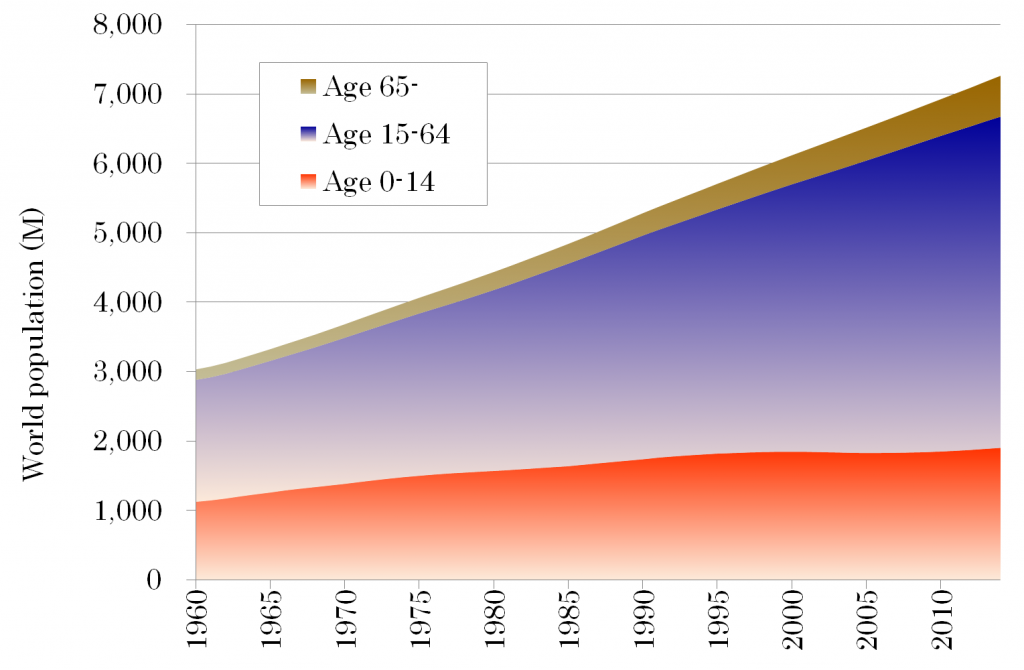■ Demographic Situation in Each
These demographical features are very useful to judge the market of a country. Age distribution as well as a growth rate of population tell us if the country is staying young and still growing in population or if the country has already been matured and cannot expect more population growth.
Consumer’s preferences on the market highly depend on these demographic situation. In Part 1 of this agenda we said the world is aging. Then how about the situation in each country? What factors affect the degree of aging in each country? To answer these questions, Figure 4 is prepared below.
Fig.4 World Population of Age 65 or Above
 Source: World Development Indicator, World Bank
Source: World Development Indicator, World Bank
This figure shows percentage of age 65 or above out of total population by income level. There is 16% of age 65 or above out of total population in high income economies when only 6% in low and middle income economies.
Here, high-income economies are those in which 2014 Gross National Income (GNI) per capita was $12,736 or more. Low and middle-income economies are those in which 2014 GNI per capita was $12,735 or less.
It is vital to note that a degree of aging is different among countries. Wealthy countries are aging more rapidly than other countries. You may be able to understand this intuitively. One effective reason for this is that life expectancy in wealthy countries is longer than those of less wealthy. Yes, the higher the income, the longer you can live.
■ How About Japan?
Now we move on to Japan. Previous discussion was in some sense a preparation of the introduction of Japan’s situation. Having said that, let’s move our eyes on the next figure, Figure 5. This figure exactly presents what Japan’s data has been added on Figure 4.
Fig.5 World Population of Age 65 or Above #2
 Source: World Development Indicator, World Bank
Source: World Development Indicator, World Bank
High-income economies exceed low and middle-income economies in post-productive population ratio, and Japan exceeds high-income countries with wide margin. Besides, change has occurred in a very short notice. This rapid change of demography impose tremendous adaptation on Japan’s society.
Figure 6 is a Japanese version of Figure 3 presented in Part 1, which expresses the world population and its annual growth rate. You can find out that Japan seems to have passed a peak of not only growth rate but also population itself already.
Fig.6 Growth Rate of Japan’s Population
 Source: Population Census, Statistics Bureau, Ministry of Internal Affairs and Communications
Source: Population Census, Statistics Bureau, Ministry of Internal Affairs and Communications
Statistic says that Japan’s population has turned to decrease since 2011. The trend will lead Japan’s population to decrease more. Of course there are lots of countries in which population is decreasing. However, Japan’s change is characterized by its speed.
■ Rapid Change
For expressing rapid change in Japan, annual growth rate of population both in Japan and the world are plotted in the same graph as shown Figure 7.
Fig.7 Growth Rate in the World and Japan
 Source: Population Census, Statistics Bureau, Ministry of Internal Affairs and Communications and World Development Indicator, World Bank
Source: Population Census, Statistics Bureau, Ministry of Internal Affairs and Communications and World Development Indicator, World Bank
Both growth rates look like staying on the same trend until the beginning of 1960. Then both came to their peaks. Yes, both behaved similar. Besides, the peak year of growth rate on the world seems to come earlier than the peak year of Japan.
But rapid decline of Japan’s growth rate has led Japan’s population decrease since growth rate marks negative in recent years. As a result of rapid decline of the rate, population of productive age as well as pre-productive age is decreasing as shown in Figure 8.
Fig.8 Japan’s Population by Age Group
 Source: Population Census, Statistics Bureau, Ministry of Internal Affairs and Communications
Source: Population Census, Statistics Bureau, Ministry of Internal Affairs and Communications
■ For Finding an Effect of Aging
Having kept in mind that Japan is aging much more rapidly than any other country in the world, we will focus on Japan’s demographic situation deeply as the next topic apart from international comparison.
Though looking at the situation deeply, the main purpose here in this Home Page is not for exploring a mechanism of rapid aging but for finding an effect of aging on consumer’s behavior. Aging may have a negative effect on productive activity, but it may create a new business opportunity in a market.
Detailed discussion along with the purpose will be tackled.
 Source: World Development Indicator, World Bank
Source: World Development Indicator, World Bank Source: World Development Indicator, World Bank
Source: World Development Indicator, World Bank Source: International Data Base, U.S. Census Bureau
Source: International Data Base, U.S. Census Bureau